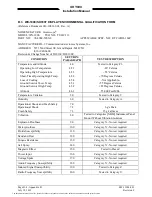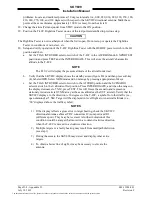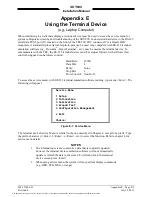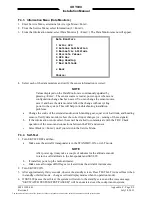
SKY899
Installation Manual
Page D-4 - Appendix D
009-11900-001
July 18, 2013
Revision F
problems. Locate and mark test points at 30 degree intervals (i.e., 000, 030, 060, 090, 120, 150, 180,
210, 240, 270, 300, and 330 degrees) with respect to the SKY899 directional antenna. Mark these
points at the same distance, approximately 100 ft. (or less), from the aircraft.
18. Change the aircraft's transponder from STBY mode to the ON position.
19. Position the T-49C Flightline Tester on one of the test points identified in previous step.
CAUTION
The Flightline Tester is not weatherproof when the lid is open. Do not setup or operate the Flightline
Tester in conditions of rain, sleet, etc.
20. Setup and verify operation of the T-49C Flightline Tester with the HI/LOW power switch in the HI
position and then:
a.
Set the TCAS INTRUDER selector switch of the T-49C to the ATCRBS/Mode-S XPDR TEST
position and press TEST and the INTERROGATE. This will store the aircraft’s barometric
altitude in the T-49C.
NOTE
The T49-C will display the pressure altitude of the aircraft under test.
b.
Verify that the SKY899 display shows the standby screen (figure D-3) and then press soft-key
(4), labeled OPR. Select NRM mode and 6 nm range by pressing appropriate soft-keys.
c.
Set the TCAS INTRUDER selector switch to the ATCRBS position and the SCENARIO
selector switch to the 0 altitude offset position. Press INTERROGATE, and when the range on
the display decreases to 5 NM, press TEST. This will freeze the scenario and represent a
stationary intruder aircraft 5 NM away at the same altitude as the UUT aircraft. Verify that the
SKY899 displays, in the direction (±30 degrees) of the T-49C, a symbol for other traffic (i.e.,
open diamond) at 5 NM. Target will be displayed in level flight at own aircraft altitude (i.e.,
“00” displayed above the traffic symbol).
NOTES
1) If the display reflects a gross error in target bearing, check the SKY899
directional antenna cables at TRC connectors J9 (sum port) and J11
(difference port). They may be reversed. A further indication of this
condition would be a target that moved in a counter-clockwise direction
when the T-49C is moved in a clockwise direction.
2) Multiple targets or a faulty bearing may result from multipath distortion
(see step 1).
3) During these tests, the SKY899 may detect and display other active
targets.
4) To obtain a better line of sight, it may be necessary to elevate the
antenna.
The document reference is online, please check the correspondence between the online documentation and the printed version.






























